Text preview of this CV template:
This is a text-only preview - download the formatted Word file using the link above.
ELLA JONES | Programmer
CONTACT
124, High Street, Nottingham NG1 2DY | (0115) 9456789 | ellajones@hotmail.com
OBJECTIVE
I am an experienced game programmer with an excellent working knowledge of C++ and C#. I have worked extensively with a range of game engines and technologies including Unity, Unreal Engine 4, CryEngine and more.
My experience includes creating, developing and tuning gameplay systems. I also provide design input for prototyping and testing new features where required. I am looking for a full-time role closer to home.
WORK HISTORY
Game Programmer
September 2017 – date
Swift Games, Derby
After a short break from work due to a now-fully-resolved health issue, I began work for this exciting games company.
My responsibilities include developing and extending game systems across a wide variety of areas such as AI, Audio, Game logic, Networking, Physics, Vehicles, Weapons and Player control. I prototype and iterate on game features, writing clear, maintainable and decoupled code while working closely with the design team.
I provide detailed input and feedback on game design and implementation, always striving to improve the stability, usability and architecture of the game code and engine.
This role required a broad knowledge of animation, continuous integration, multi-threading, optimisation, physics, build systems, resource management and scene management. I am looking for a new role due to relocating.
Game Programmer
May 2016 – April 2017
Blue Horizon Games Limited
In this 12 month contract I architected systems and features which empowered the wider team to deliver immersive experiences and emergent gameplay scenarios.
I was a part of the full development cycle, having plenty of opportunity to be creative and independent in my work.
My work included regularly solving technical challenges and working hard to make a big difference to the whole game team’s workflow.
Assistant Game Programmer
November 2015 – Apr 2016
Excitement Games
In this six-month contract, I assisted a variety of customers in establishing technical requirements from creative and design-led pitches.
I then worked with different engines and technologies to implement features for multiplayer games (e.g. combat mechanics, AI behaviours, pathfinding).
Junior Game Programmer
May 2012 – October 2015
OYZ Industries
In this role I was part of an agile, multidisciplinary and creative team and my role was to mentor external teams on the company’s technology and make things run smoothly.
I worked closely with the team to coordinate efforts and get the best possibly results.
This role required a lot of creative thinking and the ability to stay motivated through the daily challenges that presented themselves.
SKILLS
- Demonstrable passion and knowledge for games and game development.
- Solid experience in commercial software development in C++ and C#.
- Experience in software development in a collaborative environment working on a large project.
- Methodical and investigative nature, with strong troubleshooting and debugging skills.
- Proven ability to communicate with non-technical stakeholders including producers, artists and designers.
- Proven ability to define and understand elements of game design documents and technical design documents.
- Proven ability to organise self across multiple concurrent tasks.
- Proven ability to take initiative and work independently, especially when presented with ambiguous or unusual challenges.
- The ability to establish technical requirements from creative or design-led pitches.
- Very good knowledge of notable game engines and technologies, including but not limited to Unity, Unreal Engine 4, CryEngine.
- Very well-developed communication and team skills.
QUALIFICATIONS
Various
October 2013 – date
Pluralsight
Various courses including AI for Games, Networking, Prototype Development, Research Related Learning and Animation.
BSc Game Programming (2:1)
London Metropolitan University
Completed June 2012
A-levels
Acme College, Birmingham
Computer Science (A), Electronic Engineering (A), Maths (B) and Physics (B)
HOBBIES AND INTERESTS
Metal Earth modelling
Retro Gaming
Lego
Home Brewing
Comic Books
Dungeons & Dragons.
REFERENCES
“Ella is proactive and used to taking ownership and responsibility. She is a good team player and supportive to other departments. She has excellent social, communication and presentation skills.”
~ James Lee, Manager, Swift Games | 01332 123456 | jameslee@swiftgames.com
“Ella is professional, passionate about games, a great problem solver, proactive, a solid team worker, rigorous and highly detail oriented. She is smart, willing to learn more, creative and practical at the same time. I can’t recommend her enough.”
~ Sam Johnson, Director, Blue Horizon | 01332 234567 | samjohnson@bluehorizon.com
“Ella is a passionate developer with a broad range of talents and skills. She is a driven, productive, team player who was relentless in her pursuit of our mission. Best of all she just gets things done.”
~ Andrew Carson, Director, Excitement Games | 01332 344567 | andycarson@excitementgames.com
Template details:
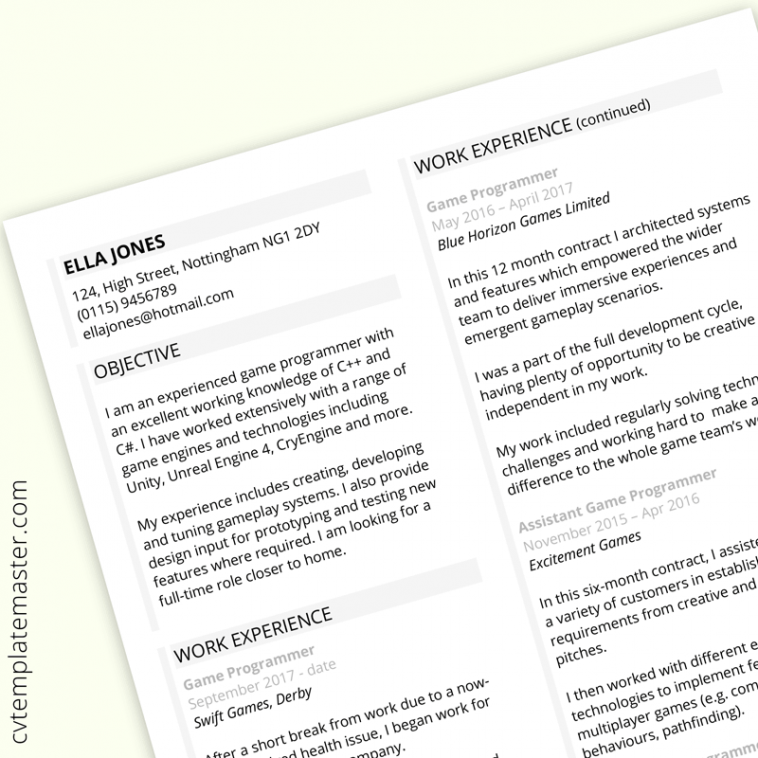
Here’s a full preview of page one of this programmer CV:
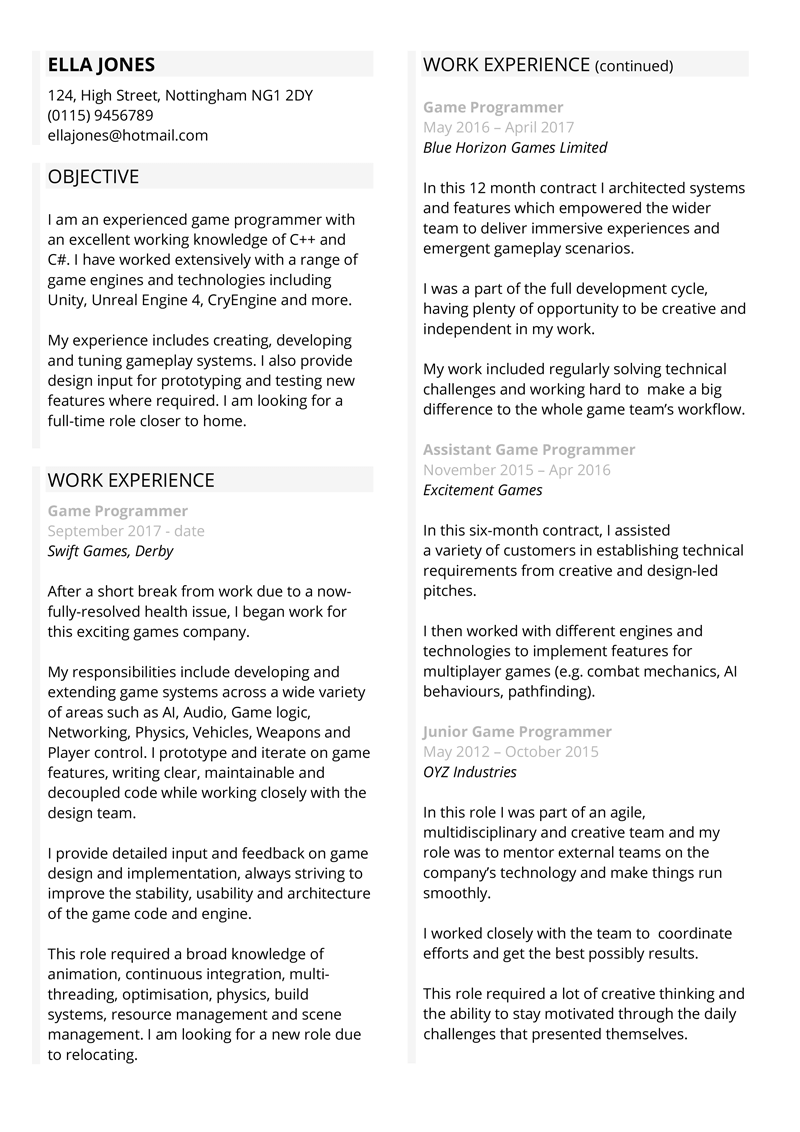
And here’s page two:
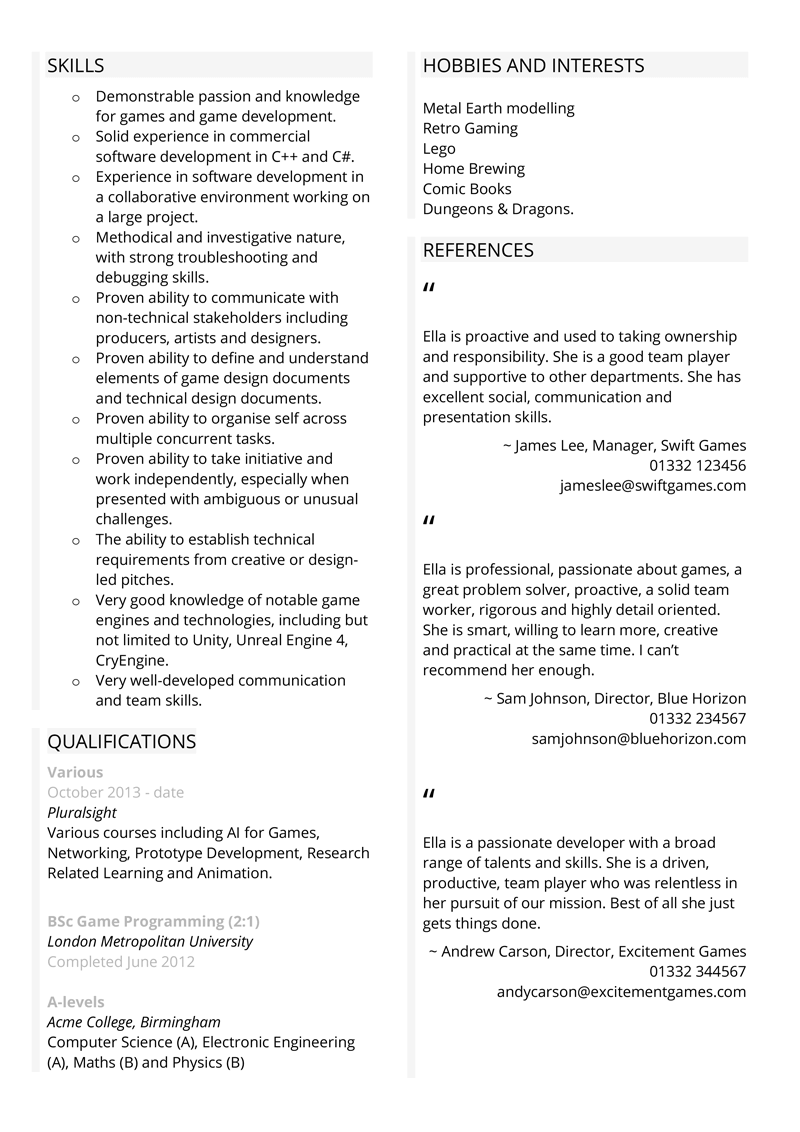
Above: Full preview of our ‘Guided’ CV template.
How to write a programmer CV
Like most CVs, a programmer CV MUST have a few core sections which are:
- Name and contact details
- Work history (in reverse chronological order, i.e. most recent first)
- Qualifications / Education section (highest to lowest)
In addition, most people will include:
- Social media profiles (Twitter/LinkedIn)
- Objective or personal statement
- Skills
- Hobbies / interests
- References
Optionally, these sections may be relevant to you:
- Memberships
- Certifications
- Awards
- Achievements
- Publications
Your personal statement is a concise professional summary of why you’re right for your target role. It is typically the first thing (and sometimes the only thing) that the hiring manager will read. Prepare this by looking at the job advert, picking out the most important requirements and setting out in no more than 3 – 4 lines how you meet them. It will likely include how many years of experience you have and your main specialisms.
Your skills section should provide more detail on which programming languages, software solutions, frameworks and packages you’re familiar with and to what level. If there are quite a few, you may want to give these their own section.
Before you set out to write each of these sections, study the job advert carefully. Every employer has different priorities, so it’s important to tailor your CV to each role you apply for. Use the same keywords as the job advert so employers can quickly see that you’re a good prospect for the role.
If the job advert is light on detail, try studying other similar programmer job adverts to see what skills employers typically want to see for this type of position. You could also look at job profiles (e.g. Games Developer on Prospects.ac.uk).
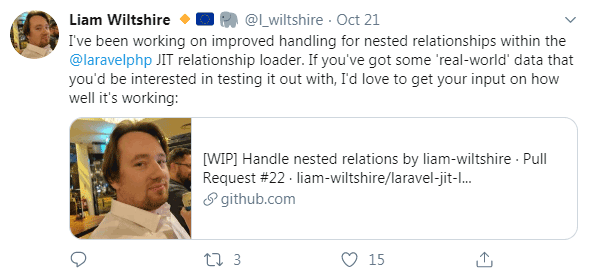
Above: Giving details of your social media profiles can be a great way to show an employer you’re involved in and passionate about the industry in which you’re working (credit: l_wiltshire). LinkedIn also allows you to create a more comprehensive work profile to complement your CV.
Highlight relevant work experience
Employers would prefer a candidate with relevant work experience so they can rest a little easier and let the new employee showcase their skills with little support. So the key to writing a fantastic work experience section is to focus upon what matters to THIS employer.
Cut out all the tasks and responsibilities for irrelevant roles, unless they demonstrate transferable skills. Only go into more detail for roles which will be of interest to the employer. Although this may seem obvious, we still see applications that list an entire career history in great detail. Often this will lead to a three or even four page CV, which is a nightmare for any hiring manager. The employer doesn’t want to see a candidate’s entire life story – they want to be able to get straight to the relevant information, shortlist the candidate and move onto the next CV.
Look back over every role and pick out the most relevant, and only go into more detail on those. Keep the tasks and responsibilities to a bare minimum for the other roles, and just state a few details. You only need to give a brief summary for the less important roles.
For the most relevant roles, let prospective employers know how you performed, what you achieved and details of any promotions and awards. Where possible, provide stats and results, such as work that exceeded a target, saved revenue or improved a process.
Use conventional job titles – if the recruiter is advertising for a ‘C++ computer programmer’, don’t use any fancy modernised titles that your past employers might have given you, such as ‘Awesome Solutions Developer’.
Keep your programmer CV on point and focused
You should never be in the position of having to pad out your CV to complete two pages. Even school leavers should be able to adequately complete a CV that contains no waffle, gets straight to the point and stays on track.
The employer will try to quickly pick out the important details, and this can only be done if you write a CV that’s short and to the point. Remain focused on what they are looking for – don’t write a generic CV and always tailor it to the role!
Using bullet points is a great way to do this as the spacing is easier on the eye than a paragraph. You can focus on ensuring each point is kept to just one line. Typically this would work well for when you list your tasks in the employment history section, but could also be used for skills and other sections.
Expand out with alternative types of work experience
If you’re an entry level programmer, consider including other types of experience to help boost your credibility. You could, for example, include details of:
- Personal programming projects
- Contributions you’ve made online (e.g. code snippets)
- Freelancing work
Use the references section to your advantage
Some people leave off references altogether and this is fine – the employer will ask for them if they offer you the job anyway. However, references aren’t typically requested until the employer is ready to offer a job which means an employer may never see your shining commendations at all!
A great way to get around this is to include a snippet from each of your references on your CV itself. We all love a good testimonial and the references section is a great place to showcase some testimonials about you! Look at the sample content in our programmer CV to see how your ‘testimonials’ can be incorporated into the references section, giving employers a powerful endorsement of your skills up front.
Originally published 16th November 2018.
More CV templates like this:
We have a range of programmer CV samples and examples from similar roles that you may find useful.
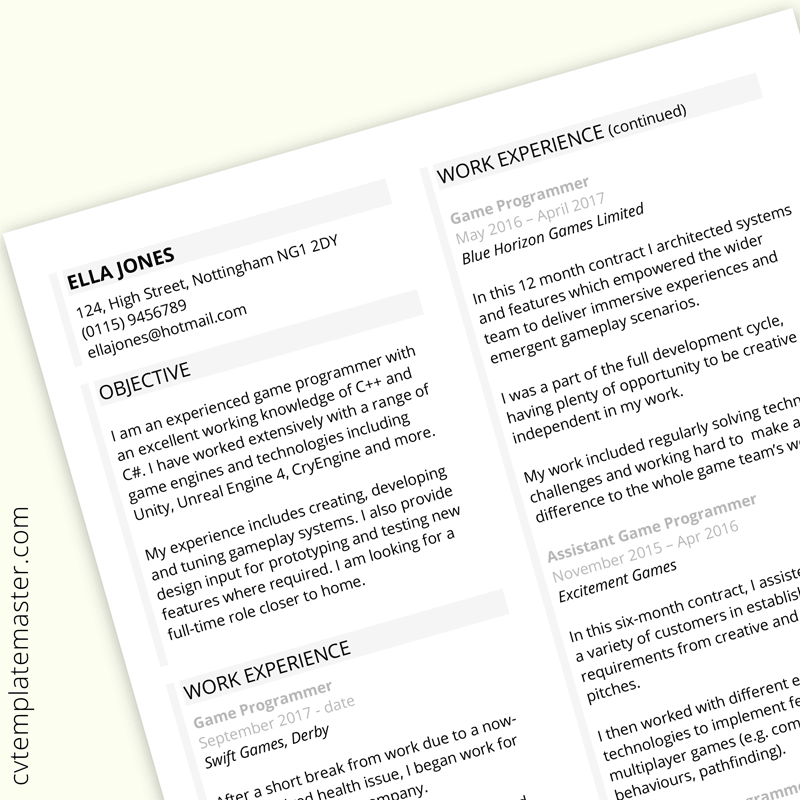
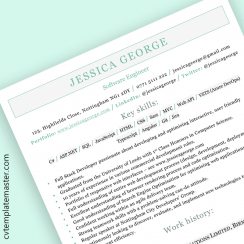
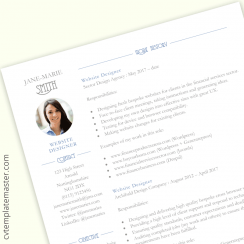
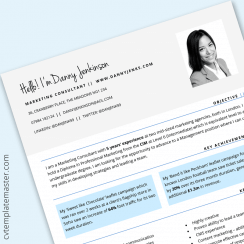
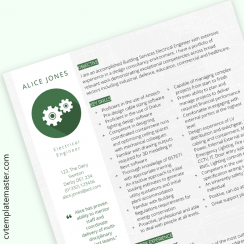
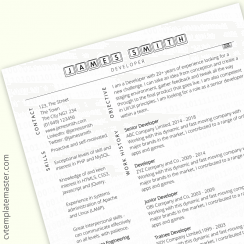
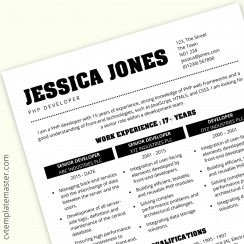
Excellent. Just what I was looking for